
After choppy seas forced NASA to scrub Tuesday’s test launch of a supersonic parachute from Wallops Island, the next chance to watch the rocket blast off is Saturday morning.
Barring bad weather, a 58-foot Terrier-Black Brant IX suborbital rocket is set to launch between 6:45 and 10:15 a.m. from Wallops Flight Facility on the Eastern Shore.
It will carry a next-generation parachute that NASA is developing to land its Mars 2020 rover safely on the Martian surface — a feat rendered especially difficult because of the planet’s super-thin atmosphere.
Called ASPIRE, for Advanced Supersonic Parachute Inflation Research Experiment, the test is the second in a series that began at Wallops last October.
ASPIRE requires launching the parachute to an altitude of about 32 miles over the Atlantic Ocean off Virginia to see how it handles conditions in Earth’s mesosphere.
“On Earth, in order to recreate that altitude and those conditions that the parachute would see on Mars, we have to go about halfway to the edge of space,” said Ian Clark, the test’s technical lead, in a recent interview.
Clark is with NASA’s Jet Propulsion Laboratory in Pasadena, Calif.
The Martian atmosphere is far too thin for a parachute alone to muster the drag needed to slow down payloads on entry from space. The parachute must also be robust enough to inflate and operate at entry speeds of nearly twice the speed of sound without tearing to shreds, said Eric Queen, the research engineer at NASA Langley Research Center in Hampton who did the aerodynamics analysis for the test vehicle.
“That initial opening is the danger point,” Queen said in a recent interview.
The supersonic parachute is an improved version of the one that safely landed the Curiosity science rover on Mars in 2012. It’s made of enhanced nylon, Kevlar and a synthetic fiber called Technora that’s many times stronger than steel.
As with the Curiosity, the parachute is required to slow the 2020 rover from scorching speeds of 1,000 mph to about 200 mph.
“At that point,” said Clark, “the parachute’s done as much as it can and we have to turn on rocket engines to slow down the rest of the way.”
Those engines are part of a special “sky crane” attached to the rover by cables and designed to hover over the surface and set the rover down gently.
NASA Langley was instrumental in developing the Curiosity’s novel entry, descent and landing system, and now is contributing to the new system.
So far, the 35,000-pound Curiosity is the heaviest total load ever landed successfully on Mars. The 2020 rover’s total load is even heavier, at 47,000 pounds.
The first test of the new parachute last October went “phenomenally well,” said Clark.
During the next launch, Queen will be in the Wallops control room, where his job, once the parachute opens, will be to quickly project where it will come down in the ocean.
“It takes a half an hour to descend on this parachute, so that gives our boats a chance to get under it or to it or towards it,” said Queen. “That way, we can get to the experiment as quickly as possible. There are concerns it could sink — it’s supposed to float, but you never know, and it really is vital to the success of the experiment to get to it and get the data cards off of it before it gets corrupted by sea water.”
This is why rough seas are a special hazard for these test launches, he said.
The launch won’t be visible from Hampton Roads, but NASA is opening its Visitor Center on Wallops Island early to accommodate the viewing public. It will also be live-streamed at nasa.gov/nasatv.
The launch window for ASPIRE runs until April 10. For updates, go to the Wallops Facebook page at facebook.com/NASAWFF.
Smartphone users can also download the “What’s Up at Wallops” app for information on the launch and a compass showing the best direction to view it.
